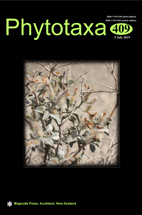Abstract
Pteroceltis (Cannabaceae) is a monotypic genus endemic to China, and relatively little is known about its fossil record. Here, we describe three new fossil-species of Pteroceltis from the early Oligocene Hoengyeong Formation of Kungshim, North Korea and the Miocene Shanwang Formation of Shandong Province, eastern China. Pteroceltis kungshimensis comb. nov. and P. taoae sp. nov. from North Korea and China possess sub-orbicular, thin-stipitate, and bilaterally winged fruits, but the former is noticeably smaller in size. Pteroceltis shanwangensis sp. nov. from the Shanwang Formation is characterized by its ovate simple leaves bearing one order of teeth and brochidodromous secondary veins including an exposed basal pair. This study shows that Pteroceltis was distributed in China, North Korea, Germany and the United States during the Paleogene. It might have become regionally extinct in North America, Europe and Northeast Asia after the Oligocene and was gradually restricted to East Asia by the Miocene. China is a living museum for Pteroceltis.

